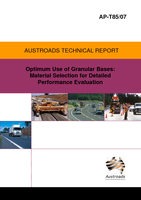Pavement

Optimum Use of Granular Bases: Material Selection for Detailed Performance Evaluation
- Publication no: AP-T85-07
- ISBN: 978-1-921329-10-4
- Published: 27 July 2007
- PDF (free) Download
The objective of this report is to provide data relating the laboratory repeated load triaxial test (RLT) results to field performance and to develop procedures for incorporation of RLT test results into performance-based specifications and mechanistic pavement design for unbound granular materials. Base materials nominated by Austroads member authorities were tested using both current empirical specification tests for material qualities and advanced laboratory test methods for mechanical properties (including resilient modulus, permanent strain and shear strength). It was found that the materials covered a large range of qualities in terms of source rock, grading and fines properties. The use of materials varies with their quality from lightly to heavily trafficked roads and from drier inland areas to wet coastal areas. Results of resilient modulus and permanent strain obtained from RLT testing indicated that the material rankings based on these parameters were not consistent with the classifications based on material qualities. Four materials were recommended for testing using accelerated loading.
- AP-T85-07 Optimum Use of Granular Bases: Material Selection for Detailed Performance Evaluation
- SUMMARY
- CONTENTS
- TABLES
- FIGURES
- 1. INTRODUCTION
- 2. NOMINATED MATERIALS
- 2.1. Victorian Granular Bases
- 2.2. South Australian Granular Bases
- 2.3. New South Wales Granular Bases
- 2.4. Summary
- 3. MATERIAL CLASSIFICATION BASED ON SPECIFICATIONTEST RESULTS
- 3.1. Source rock quality
- 3.2. Properties of Uncompacted Products
- 3.3. Properties of Compacted Products
- 3.4. Overall Material Classification
- 4. MATERIAL RANKING BASED ON MECHANICALPROPERTIES
- 4.1. Testing Methods
- 4.1.1. Repeated Load Triaxial Test
- 4.1.2. Static Triaxial Shear Test
- 4.2. Sample Preparation Method
- 4.3. Permanent Strain
- 4.3.1. Testing Program and Test Results
- 4.3.2. Comparison of Permanent Strain
- 4.4. Resilient Modulus
- 4.4.1. Resilient Modulus Testing Program and Test Results
- 4.4.2. Comparison of Resilient Modulus
- 4.5. Shear Strength
- 4.5.1. Testing Program
- 4.5.2. Comparison of Shear Strengths
- 5. SELECTION OF BASE MATERIALS FOR DETAILEDPERFORMANCE EVALUATION
- REFERENCES
- APPENDIX A AVAILABLE FIELD INFORMATION FORNOMINATED MATERIALS
- APPENDIX B REPEATED LOAD TRIAXIAL TESTINGPROGRAMS AND TEST RESULTS
- APPENDIX C RESULTS OF SHEAR STRENGTH TESTING
- INFORMATION RETRIEVAL
Related publications
Latest Pavement News
